According to the Daily Life in Ancient Rome Reading, Why Was the City of Ostia Founded?
 Market foursquare of Ostia Antica | |
| Shown within Italy | |
 Click on the map to come across marker. | |
| Location | Ostia, Province of Roma, Lazio, Italian republic |
|---|---|
| Coordinates | 41°45′21″N 12°17′xxx″E / 41.75583°Northward 12.29167°Due east / 41.75583; 12.29167 Coordinates: 41°45′21″N 12°17′xxx″E / 41.75583°Due north 12.29167°E / 41.75583; 12.29167 |
| Type | Settlement |
| Area | 50 hectares (0.l km2)[1] |
| History | |
| Abandoned | 9th century Ad |
| Cultures | Ancient Rome |
| Site notes | |
| Condition | Ruined |
| Ownership | Public |
| Public access | Yeah |
| Website | www |
Ostia Antica is a large archaeological site, shut to the modernistic boondocks of Ostia, that is the location of the harbour urban center of ancient Rome, fifteen miles (25 kilometres) southwest of Rome. "Ostia" (plur. of "ostium") is a derivation of "os", the Latin word for "rima oris". At the mouth of the River Tiber, Ostia was Rome's seaport, but due to silting the site now lies 3 kilometres (two miles) from the ocean.[two] The site is noted for the excellent preservation of its aboriginal buildings, magnificent frescoes and impressive mosaics.
History [edit]
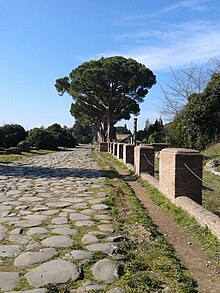
The old archway of the city
Origins [edit]
Ostia may have been Rome's first colonia. According to legend, Ancus Marcius, the 4th male monarch of Rome, was the start to destroy Ficana, an aboriginal boondocks that was but 17 km (eleven mi) from Rome and had a small harbour on the Tiber, and then proceeded with establishing the new colony x km (half-dozen mi) further west and closer to the sea coast. An inscription seems to confirm the establishment of the onetime castrum of Ostia in the 7th century BC.[3] The oldest archaeological remains so far discovered date dorsum to only the quaternary century BC.[4] The nigh ancient buildings currently visible are from the third century BC, notably the Castrum (military army camp);[5] of a slightly subsequently date is the Capitolium (temple of Jupiter, Juno and Minerva). The opus quadratum of the walls of the original castrum at Ostia provide important show for the edifice techniques that were employed in Roman urbanisation during the menses of the Middle Commonwealth.[6]
Civil wars [edit]
Ostia was a scene of fighting during the period of civil wars in the 80s BC. In 87 BC, Marius attacked the metropolis in order to cut off the catamenia of trade to Rome. Forces led by Cinna, Carbo and Sertorius crossed the Tiber at three points before capturing the city and plundering it. After his victory here, Marius moved on to set on and capture Antium, Aricia and Lanuvium to further destroy the foodstores of Rome.[7]
Sacking past pirates [edit]
In 68 BC, the town was sacked by pirates.[eight] During the sack,[ix] the port was set up on fire, the consular war fleet was destroyed, and two prominent senators were kidnapped. This assault acquired such panic in Rome that Pompey the Peachy arranged for the tribune Aulus Gabinius to ascent in the Roman Forum and propose a law, the lex Gabinia, to permit Pompey to heighten an army and destroy the pirates. Within a year, the pirates had been defeated.[10]
The boondocks was and so re-built, and provided with protective walls by the statesman and orator Marcus Tullius Cicero.[eleven]
Imperial Ostia [edit]


During Julius Caesar's time equally Dictator, ane of his improvements to the urban center was his establishment of better supervision of the supply of grain to Rome. He proposed amend admission to grain by the use of a new harbour in Ostia along with a canal from Tarracina.
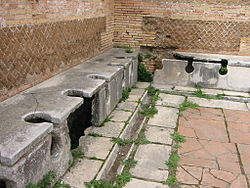
The town was further developed during the first century AD under the influence of Tiberius, who ordered the edifice of the town'southward showtime Forum. The boondocks was too soon enriched past the construction of a new harbour on the northern mouths of the Tiber (which reaches the sea with a larger oral fissure in Ostia, Fiumara Grande, and a narrower one near to the current Fiumicino International Airport). The new harbor, not surprisingly called Portus, from the Latin for "harbour", was excavated past guild of the Emperor Claudius. This harbour became silted up, and needed to be supplemented later past a harbour built past Trajan finished in the yr 113 Advertizement; it has a hexagonal form,[12] in order to reduce the erosive forces of the waves.[ citation needed ] Moreover, at a relatively short distance, there was too the harbour of Civitavecchia (Centum Cellae). These elements took business organisation away from Ostia itself and began its commercial turn down.[12] In 2008 British archaeologists discovered the remains of the widest culvert ever congenital by the Romans, 300 anxiety wide, which they believe ran from Portus beyond the Isola Sacra to the Tiber opposite Ostia, which would accept made the send of large quantities of goods far easier than by land transport. In 2014, ruins were discovered on the north side of the river opposite the urban center indicating a big built-up area with some massive structure. Within its walls, Ostia covered an area of 69 hectares or 173 acres. During the quaternary century, the city spilled over the southern walls to the sea southward of Regioni III and 4 on the map.
Ostia itself was provided with all the services a town of the time could require; in particular, a famous lighthouse. The popularity of the Cult of Mithras is evident in the discovery of eighteen mithraea.[13] Archaeologists have also discovered the public latrinae, organised for commonage utilize equally a serial of seats that let us to imagine today that their part was also a social one. Ostia had a large theatre, many public baths (such every bit the Thermae Gavii Maximi, or Baths at Ostia), numerous taverns and inns and a firefighting service. Ostia also independent the Ostia Synagogue, the earliest synagogue yet identified in Europe; it created a stir when information technology was unearthed in 1960–61.[14]
Late-Roman and sub-Roman Ostia [edit]

Ostia grew to fifty,000 inhabitants in the 2nd century, reaching a acme of some 100,000 inhabitants in the 2nd and 3rd centuries Advertisement.[15] [16] [17] Ostia became an episcopal see as office of the Diocesi of Rome equally early as the third century AD; the cathedral (titulus) of Santa Aurea existence located on the burial site of St Monica, mother of Augustine; she died here in 387 in a business firm holding of the Diocesi of Rome.
In time mercantile activities became focused on Portus instead. For scholars of the High Empire Ostia was the seaside version of Rome, the urban center of flat buildings. Information technology used to be thought that the urban center entered a catamenia of slow turn down afterwards Constantine I made Portus a municipality, Ostia thereby ceasing to be an active port and instead becoming a popular land retreat for rich aristocrats from Rome.[12] In spite of the fact that Portus shows substantial growth in the 4th century, the traditional view that Ostia went into marked pass up has had to be revised due to recent excavations and re-evaluation of the show. The knocking downward of some apartment blocks replaced past houses of the rich was "thought to have signalled the disappearance of Ostia'southward once-vibrant group of not-elite residents and labourers"..."recent research has suggested we take a more nuanced view of residential patterns and social demography in the Late Antique city".[eighteen] Earlier views of disuse relied on fleeting references in the ancient sources and excavators ignoring show from the flow that the boondocks continued to thrive despite pockets of decay into the sixth century, "..life in Ostia ended non with a Vesuvian bang only with a whimper" subsequently a slow decline from the 6th to the 9th centuries.
The metropolis housed the headquarters of the Prefect of the Annona and his large staff. Although there are signs of decay in sure quarters, prove indicates continued prosperity through fifth century, including: repairs on baths (26 remained in operation during the quaternary century), public buildings, church construction, street repaving, residential and business expansion beyond the perimeter of the due south wall (the presence of a small harbour, the Porta Marina on the sea, is attested), a huge quaternary century villa located due east of the Maritime baths, and the connected operation of the river port on the western edge of the boondocks, the 'navalia', a squarish basin congenital in from the river, a warehouse on the due east side and, behind information technology, a large bath complex, erroneously called the palazzo imperial.[nineteen] Numerous bathing establishments are recorded as still operating in the 4th and into the 5th centuries with major repairs of the centre-city Neptune Baths in the 370s.
The city was mentioned past St Augustine when he passed there in the belatedly quaternary century.[twenty] On their way back to Africa afterwards Augustine's conversion to Christianity, Augustine'south mother, Saint Monica, died in 387 in Ostia, while at a business firm property of the Diocesi of Rome [21]
The poet Rutilius Namatianus reported the lack of maintenance of the metropolis ports in 414 Advert.[22] This view has been challenged by Boin, who states Namatianus' poetry is a literary construct and not consistent with the archaeological record, ibid. pp. 22, 25, (the poet was lamenting the lost greatness of Rome later on the sack of 410 and was hoping for the rise again of the corking city).
After the cease of the Western Roman Empire in 476 (traditional appointment: Julius Nepos died 480 was the concluding legitimate emperor), Ostia vicious slowly into disuse as the population of Rome, 700–800,000 in A.D. 400 contracted to 200,000 or less in 500 A.D. The city was finally abandoned in the 9th century[23] due to the repeated invasions and sackings by Arab pirates. A naval battle, the Battle of Ostia, was fought there in 849 between Christians and Saracens; the remaining inhabitants moved to Gregoriopolis a curt altitude abroad.[12]
Sacking and excavation [edit]

Ostia housed a belatedly imperial mint; this coin of Maxentius was struck at that place.
A "local sacking" was carried out by Baroque architects,[ when? ] who used the remains as a sort of marble storehouse for the palazzi they were building in Rome.
The Papacy started organizing its own investigations with Pope Pius Seven.
Under Benito Mussolini massive excavations were undertaken from 1939 to 1942[4] during which several remains, particularly from the Republican Catamenia, were brought to low-cal. These were interrupted when Italian republic became a major battleground of Earth War Two.
In the post-state of war period, the outset volume of the official serial Scavi di Ostia appeared in 1954; it was devoted to a topography of the town past Italo Gismondi and after a hiatus the inquiry all the same continues today. Though untouched areas adjacent to the original excavations were left undisturbed pending a more than precise dating of Roman pottery types, the "Baths of the Swimmer", named for the mosaic figure in the apodyterium, were meticulously excavated, in 1966–70 and 1974–75, in part as a training ground for young archaeologists and in part to establish a laboratory of well-understood finds as a education aid.
It has been estimated that two-thirds of the aboriginal town are every bit withal unexcavated. In 2014, a geophysical survey using magnetometry, amongst other techniques, revealed the existence of a boundary wall on the northward side of the Tiber enclosing an unexcavated surface area of the city containing 3 massive warehouses.[24] [25]
Modernistic day [edit]
The excavated site of Ostia Antica is open to the public as a tourist allure. A number of finds from the excavation are housed on-site in the Museo Ostiense.[26] The site has dining, and other facilities.[27] The Theatre is also occasionally used for cultural events.[28]
Media [edit]
- Ostia was featured in the novels I, Claudius and Claudius the God, both written past British novelist Robert Graves. The novels include scenes set at Ostia spanning from the reign of Augustus to the reign of Claudius, including the difference of Agrippa to Syria and Claudius's reconstruction of the harbour. In the 1976 tv set series, Ostia was often mentioned simply never really seen.
- Ostia features in A War Within: The Gladiator by Nathan D. Maki. After an bump-off endeavor on Emperor Commodus the protagonists Antonius and Theudas escape by clinging to a clomp on the Tiber, reaching Ostia, and stowing away on a trireme heading northward to Ravenna.
- Ostia appears briefly towards the cease of the Roman Empire section of the 1981 one-act film History of the World, Office I, where the principal characters board a galleon (bearing the El Al logo) jump for Judaea. In the film, withal, Ostia is simply ever referred to as simply "the port".
- Ostia's beach and port serves as the location for the 1993 music video of the vocal "La solitudine" by Laura Pausini.
- Ostia is mentioned several times in the 2005 HBO/BBC historical drama series Rome.
- Ostia is mentioned in the 2000 picture Gladiator, when the protagonist, Maximus, learns that his army is camped at Ostia and awaiting orders.
- I of the wonders buildable in the "Ascent and Fall of the Roman Empire" modern for Sid Meier's Civilisation Three is called the "Portus Ostiae".
- Ostia is the name of the Magic World'southward lost kingdom and the location of the gladiatorial games in the manga series Negima! Magister Negi Magi.
- Ostia is the proper noun of the nearly of import metropolis of the Lycian Alliance in the Fire Emblem series.
- Ostia is mentioned in several novels in Lindsey Davis' Marcus Didius Falco series.
- Ostia is featured in the film Rome Take a chance from 1962.[29]
- Ostia is a central location in the children'south novel series The Roman Mysteries by Caroline Lawrence, and its television adaption.
Gallery [edit]
-

The inscription originally placed on the main gate.
-

The theatre as seen from the ancient chief road.
-

Within the theatre.
-
Remains of an apartment block from the early 2nd century AD almost the centre of the town
-
Mosaic floor in the baths, dating from the 2nd century AD
-
Warehouses along the old Tiber banks
-

-
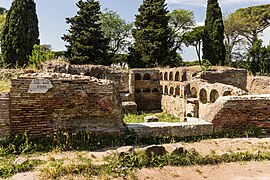
Via delle Tombe
-

Main Baths
Notes [edit]
- ^ "History - Ostia Antica". www.ostiaantica.beniculturali.it. Archived from the original on 13 July 2017. Retrieved 2 September 2017.
- ^ "Ostia-Introduction", OSTIA Harbour City of Ancient Rome, 2008, retrieved 2008-10-24 ,
The ancient Roman city of Ostia was in antiquity situated at the mouth of the river Tiber, some 30 km (xix miles) to the westward of Rome. The shoreline moved seawards, due to silting, from the Middle Ages until the 19th century. Therefore Ostia is today still lying next to the Tiber, just at a distance of some three kilometres (ane.ix miles) from the beach. Ostia is Latin for "rima oris", the rima oris of the Tiber. The river was used as harbour, but in the Purple flow two harbour basins were added to the north, virtually Leonardo da Vinci aerodrome. The harbour commune was called Portus, Latin for "harbour".
- ^ "Ancus Marcius, the 4th of the kings from Romulus after the founding of the metropolis [Rome] founded this first colony" (Anco Marcio regi quarto a Romulo qui ab urbe condita primum coloniam --- deduxit).
- ^ a b "Ostia - Italy". britannica.com.
- ^ "Ostia - Introduction". www.ostia-antica.org.
- ^ White, Michael. "OSMAP Building Types". www.laits.utexas.edu . Retrieved 1 September 2017.
- ^ Appian, The Civil Wars, 1.eight, ed. Horace White, 1899
- ^ Harris, Robert (September 30, 2006). "Stance | Pirates of the Mediterranean" – via NYTimes.com.
- ^ Cicero, On the Control of Cn. Pompeius, 33
- ^ Cicero, Marcus Tullius; Yonge, C. D. (Transl.). "To the citizens on Gnaeus Pompeius'due south command". Wikisource . Retrieved 1 September 2017.
For why should I mutter of the disaster of Ostia, and of that stain and absorb on the democracy, when almost under your very eyes, that fleet which was nether the command of a Roman delegate was taken and destroyed past the pirates? O ye immortal gods! could the incredible and godlike virtue of i human in so short a fourth dimension bring so much light to the republic, that you who had lately been used to see a fleet of the enemy before the mouth of the Tiber, should now hear that there is non ane ship belonging to the pirates on this side of the Atlantic? 34And although yous take seen with what rapidity these things were done, still that rapidity ought non to be passed over past me in speaking of them.—For who e'er, fifty-fifty if he were simply going for the purpose of transacting business or making profit, contrived in so brusque a time to visit so many places, and to perform such long journeys, with as cracking celerity as Cnaeus Pompeius has performed his voyage, bearing with him the terrors of war as our general? He, when the weather could hardly be called open for sailing, went to Sicily, explored the coasts of Africa; from thence he came with his armada to Sardinia, and these three great granaries of the commonwealth he fortified with powerful garrisons and fleets; 35when, leaving Sardinia, he came to Italy, having secured the two Spains and Cisalpine Gaul with garrisons and ships. Having sent vessels also to the coast of Illyricum, and to every part of Achaia and Greece, he also adorned the two seas of Italian republic with very large fleets, and very sufficient garrisons; and he himself going in person, added all Cilicia to the dominions of the Roman people, on the twoscore-ninth day later on he set out from Brundusium. Will the pirates who were anywhere to be plant, were either taken prisoners and put to decease, or else had surrendered themselves voluntarily to the ability and authorisation of this 1 man.
- ^ [1], Ostia Antica, A guide to Excavations, Pellegrino, 2000
- ^ a b c d "Ostia - Italian republic". Encyclopedia Britannica . Retrieved 1 September 2017.
- ^ Griffith, Alison. "Topographical dictionary - Mithraism". world wide web.ostia-antica.org . Retrieved 1 September 2017.
- ^ L. Michael White, "Synagogue and Society in Purple Ostia: Archaeological and Epigraphic Show" The Harvard Theological Review 90.1 (Jan 1997), pp 23-58; Anders Runesson, "The Oldest Original Synagogue Building in the Diaspora: A Response to L. Michael White" HTR 92.4 (Oct 1999), pp 409-433; L. Michael White "Reading the Ostia Synagogue: A Reply to A. Runesson", HTR 92.four (October 1999), pp 435-464.
- ^ Norton, Paul. ":: TRAVEL THRU HISTORY - History ::". world wide web.travelthruhistory.com. Archived from the original on 2014-04-14. Retrieved 2014-04-thirteen .
- ^ Tigay, Alan M. (24 September 1994). "The Jewish Traveler: Hadassah Magazine'south Guide to the World'southward Jewish Communities and Sights". Rowman & Littlefield – via Google Books.
- ^ Garwood, Duncan (24 September 2018). "Mediterranean Europe". Lonely Planet – via Google Books.
- ^ Ostia in Late Antiquity, Douglas Boin, 2013, Cambridge University, p. 65 ISBN 978-ane-316-60153-ii
- ^ ibid. pp. 21, 24, 52-53, 56, 57-65, 165, 231-236
- ^ "St. Augustine at Ostia". celt.ucc.ie . Retrieved i September 2017.
- ^ Augustine, E. (1977). Confessions . London: Penguin. pp. 196–197. ISBN014044114X.
- ^ "RUTILIUS NAMATIANUS". www.ostia-antica.org . Retrieved 1 September 2017.
- ^ Pasquale, Maria. "A Guide to Exploring Ostia Antica, Rome's Aboriginal Port City". Culture Trip.
- ^ Thomas, Emily (17–19 Apr 2014). "Archaeologists Unearth New Areas Of Ancient Roman Metropolis". huffingtonpost.com . Retrieved 4 May 2014.
- ^ Earl, Graeme. "New city wall discovered at Ostia". University of Southampton. Retrieved 4 May 2014.
- ^ "The Ostiense Museum - Ostia Antica". www.ostiaantica.beniculturali.it. Archived from the original on ii September 2017. Retrieved two September 2017.
- ^ "Ostia - Visiting the ruins". www.ostia-antica.org . Retrieved two September 2017.
- ^ "Teatro romano di Ostia Antica". www.turismoroma.information technology . Retrieved 2 September 2017.
- ^ "Rome Adventure, Filming Locations". IMDB.com. IMDB. Retrieved January 25, 2017.
References [edit]
- Boatwright, Mary Taliaferro. The Romans: From Village to Empire. second ed. New York: Oxford UP (2012): 248
- Hermansen, Gustav 1982. Ostia: Aspects of Roman City Life (Edmonton: University of Alberta Printing)
- Meiggs, R. (1960) 1973. Roman Ostia 2nd ed. (Oxford University Printing) The standard overview.
- Packer, James Due east. 1971 The Insulae of Imperial Ostia" M.Am.Acad. Rome 31
- Pavolini, C. 'Ostia: Guida Archeologica Laterza (Rome:Laterza) (Italian)
- Priester, S. Vielgeschossige Wohnbauten außerhalb der Tibermetropole, in: Advertising summas tegulas. Untersuchungen zu vielgeschossigen Gebäudeblöcken mit Wohneinheiten und insulae im kaiserzeitlichen Rom, L'Erma Di Bretschneider, Roma 2002, pp. 217 ff.
- Lorenzatti Sandro, Ostia. Storia Ambiente Itinerari Roma 2007 (Rome:Genius Loci)
External links [edit]
Source: https://en.wikipedia.org/wiki/Ostia_Antica

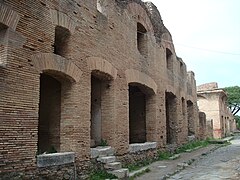

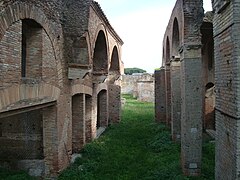
0 Response to "According to the Daily Life in Ancient Rome Reading, Why Was the City of Ostia Founded?"
Post a Comment